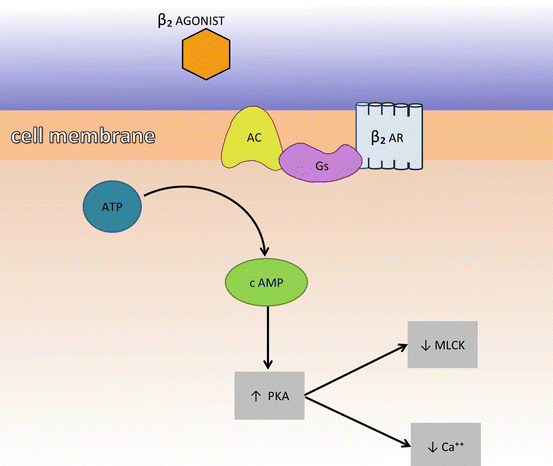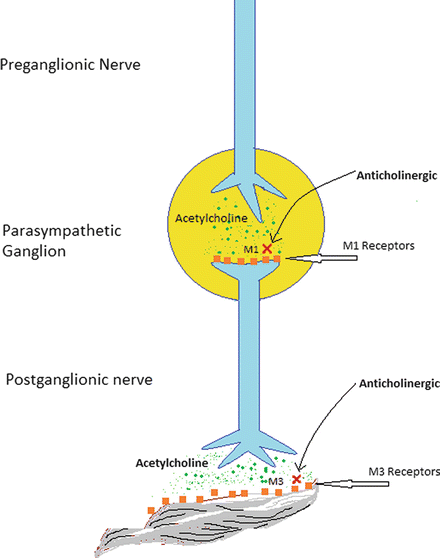Mechanism of Action of β2 Agonists
Activation of β2 receptors (β2AR) by β2 agonist results in activation of adenylyl cyclase (AC) via a stimulatory G protein (Gs). This leads to an increase in intracellular cyclic AMP (cAMP) and activation of phosphokinase A (PKA) (Fig. 12.1).


Fig. 12.1
Activation of adenylyl cyclase (AC) leads to an increase in intracellular cyclic AMP and activation of phosphokinase A (PKA). PKA phosphorylates a variety of target substrates which result in smooth muscle relaxation and bronchodilatation. Note: β2AR – Beta-2 Agonist Receptor; Gs – Stimulatory G protein; MLCK – Myosin Light Chain Kinase
PKA phosphorylates a variety of target substrates, the activities of which cause among others, reduction of myosin light chain kinase (MLCK) activity and intracellular calcium. In addition, β2 agonists open up calcium-activated potassium conductance channels and cause hyperpolarization of airway smooth muscle cells. The combination of decreased MLCK activity, decreased intracellular calcium, and increased membrane potassium conductance lead to smooth muscle relaxation and bronchodilatation.
Regular use of β2 agonists, particularly the SABAs, may result in down regulation of β2 receptors and reduced efficacy. Consequently, for these individuals, higher doses are required during acute exacerbation of symptoms. Their side effects include palpitation, tachycardia, nervousness, tremor and arrhythmia.
Inhaled Anticholinergics
This category of drugs is also used for managing patients with bronchospasm. Likewise, they are classified according to their duration of action (Table 12.2). The onset of action of ipratropium is slower (15–20 min) than the β2 agonists and hence it is not ideal as a reliever drug. However, it could be used in combination with short-acting β2 agonists to relieve acute symptoms. Combination therapy of long-acting anticholinergics and long-acting β2 agonists are being used as maintenance therapy for patients with chronic obstructive pulmonary disease (COPD), who do not achieve optimal symptom control with either drug alone.

Table 12.2
Inhaled anticholinergics

Mechanism of Action of Anticholinergics
Under normal resting condition, the airways are maintained in tonic bronchoconstriction due to continuous background activities of parasympathetic nerves. This effect is exerted through acetylcholine released from the preganglionic and postganglionic nerve endings and mediated via the M1 receptors (parasympathetic ganglia) and M3 receptors (the smooth muscles of the bronchi). The action of acetylcholine can be blocked at the M1 and M3 receptors by means of an anticholinergic (Fig. 12.2).


Fig. 12.2
Bronchoconstriction is caused by acetylcholine released from the preganglionic and postganglionic nerve endings and mediated via the M1 receptors (at parasympathetic ganglia) and M3 receptors (at smooth muscles of the bronchi). An anticholinergic agent reverses this effect
Side Effects
Their side effects include dry mouth, blurred vision, worsening of glaucoma and urinary retention.
Other Drugs Acting on the Respiratory System
Whilst many of these drugs may be administered by the inhalation route to the respiratory system, certain drugs are administered by the intravenous route in the acute situation, to produce effects in the respiratory system.
Methylxanthines
These drugs are used mainly for bronchodilatation. However, they have also been shown to have mild anti-inflammatory effect and inotropic effect on the myocardium and diaphragmatic muscles. A synergistic effect with corticosteroids has recently been demonstrated in several studies.
The two commonly used agents are theophylline (oral form) and aminophylline (intravenous form). As these drugs have narrow therapeutic windows, care should be taken with their use. Even when these drugs are within the therapeutic range, toxicity can occur. Close monitoring of blood levels is strongly advised. The side effects of these drugs include cardiac arrhythmias, seizure, headache, diuresis, nausea, epigastric/abdominal pain and diarrhoea.
Mechanism of Action
These drugs act through the inhibition of phosphodiesterase and this results in an increase in cAMP which leads to the activation of protein kinase A and other target proteins that culminate in the relaxation of airway smooth muscle. It also activates histone deacetylase which causes deactivation of core histones and thereby suppression of inflammatory genes and proteins.
Corticosteroids
This group of drugs is one of the commonest classes of drugs used in inflammatory lung diseases due to their potent anti-inflammatory effects. They are particularly useful in suppressing eosinophilic inflammation (e.g., asthma), but much less effective against neutrophilic inflammation (e.g., COPD).
In acute exacerbation of asthma, the oral and parenteral administrations of corticosteroids are equally effective. The onset of action for their anti-inflammatory effects is often delayed (about 6 h). Hence, they are administered with β2 agonists or anticholinergics which have more immediate onset of action, while awaiting the anti-inflammatory effects to take place.
Stay updated, free articles. Join our Telegram channel

Full access? Get Clinical Tree


